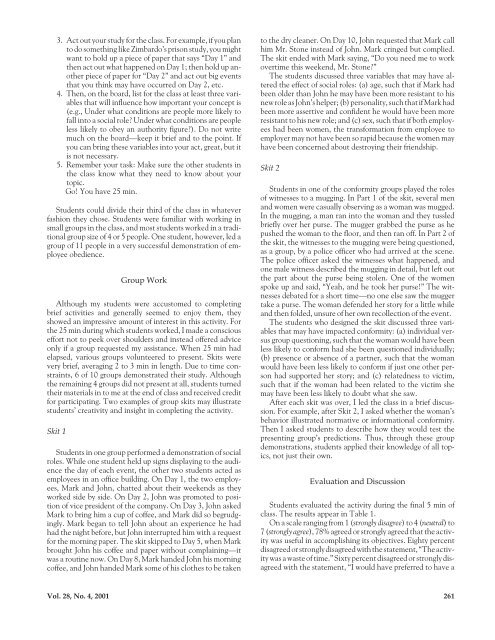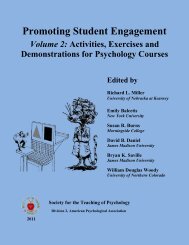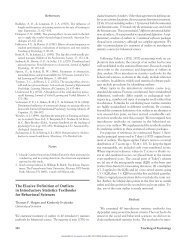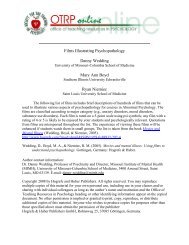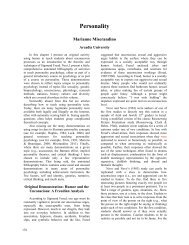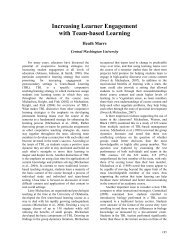Obedience, Conformity, and Social Roles: Active Learning in a ...
Obedience, Conformity, and Social Roles: Active Learning in a ...
Obedience, Conformity, and Social Roles: Active Learning in a ...
Create successful ePaper yourself
Turn your PDF publications into a flip-book with our unique Google optimized e-Paper software.
3. Act out your study for the class. For example, if you plan<br />
to do someth<strong>in</strong>g like Zimbardo’s prison study, you might<br />
want to hold up a piece of paper that says “Day 1” <strong>and</strong><br />
then act out what happened on Day 1; then hold up another<br />
piece of paper for “Day 2” <strong>and</strong> act out big events<br />
that you th<strong>in</strong>k may have occurred on Day 2, etc.<br />
4. Then, on the board, list for the class at least three variables<br />
that will <strong>in</strong>fluence how important your concept is<br />
(e.g., Under what conditions are people more likely to<br />
fall <strong>in</strong>to a social role? Under what conditions are people<br />
less likely to obey an authority figure?). Do not write<br />
much on the board—keep it brief <strong>and</strong> to the po<strong>in</strong>t. If<br />
you can br<strong>in</strong>g these variables <strong>in</strong>to your act, great, but it<br />
is not necessary.<br />
5. Remember your task: Make sure the other students <strong>in</strong><br />
the class know what they need to know about your<br />
topic.<br />
Go! You have 25 m<strong>in</strong>.<br />
Students could divide their third of the class <strong>in</strong> whatever<br />
fashion they chose. Students were familiar with work<strong>in</strong>g <strong>in</strong><br />
small groups <strong>in</strong> the class, <strong>and</strong> most students worked <strong>in</strong> a traditional<br />
group size of 4 or 5 people. One student, however, led a<br />
group of 11 people <strong>in</strong> a very successful demonstration of employee<br />
obedience.<br />
Group Work<br />
Although my students were accustomed to complet<strong>in</strong>g<br />
brief activities <strong>and</strong> generally seemed to enjoy them, they<br />
showed an impressive amount of <strong>in</strong>terest <strong>in</strong> this activity. For<br />
the 25 m<strong>in</strong> dur<strong>in</strong>g which students worked, I made a conscious<br />
effort not to peek over shoulders <strong>and</strong> <strong>in</strong>stead offered advice<br />
only if a group requested my assistance. When 25 m<strong>in</strong> had<br />
elapsed, various groups volunteered to present. Skits were<br />
very brief, averag<strong>in</strong>g 2 to 3 m<strong>in</strong> <strong>in</strong> length. Due to time constra<strong>in</strong>ts,<br />
6 of 10 groups demonstrated their study. Although<br />
the rema<strong>in</strong><strong>in</strong>g 4 groups did not present at all, students turned<br />
their materials <strong>in</strong> to me at the end of class <strong>and</strong> received credit<br />
for participat<strong>in</strong>g. Two examples of group skits may illustrate<br />
students’ creativity <strong>and</strong> <strong>in</strong>sight <strong>in</strong> complet<strong>in</strong>g the activity.<br />
Skit 1<br />
Students <strong>in</strong> one group performed a demonstration of social<br />
roles. While one student held up signs display<strong>in</strong>g to the audience<br />
the day of each event, the other two students acted as<br />
employees <strong>in</strong> an office build<strong>in</strong>g. On Day 1, the two employees,<br />
Mark <strong>and</strong> John, chatted about their weekends as they<br />
worked side by side. On Day 2, John was promoted to position<br />
of vice president of the company. On Day 3, John asked<br />
Mark to br<strong>in</strong>g him a cup of coffee, <strong>and</strong> Mark did so begrudg<strong>in</strong>gly.<br />
Mark began to tell John about an experience he had<br />
had the night before, but John <strong>in</strong>terrupted him with a request<br />
for the morn<strong>in</strong>g paper. The skit skipped to Day 5, when Mark<br />
brought John his coffee <strong>and</strong> paper without compla<strong>in</strong><strong>in</strong>g—it<br />
was a rout<strong>in</strong>e now. On Day 8, Mark h<strong>and</strong>ed John his morn<strong>in</strong>g<br />
coffee, <strong>and</strong> John h<strong>and</strong>ed Mark some of his clothes to be taken<br />
to the dry cleaner. On Day 10, John requested that Mark call<br />
him Mr. Stone <strong>in</strong>stead of John. Mark cr<strong>in</strong>ged but complied.<br />
The skit ended with Mark say<strong>in</strong>g, “Do you need me to work<br />
overtime this weekend, Mr. Stone?”<br />
The students discussed three variables that may have altered<br />
the effect of social roles: (a) age, such that if Mark had<br />
been older than John he may have been more resistant to his<br />
newroleasJohn’shelper;(b)personality,suchthatifMarkhad<br />
been more assertive <strong>and</strong> confident he would have been more<br />
resistant to his new role; <strong>and</strong> (c) sex, such that if both employees<br />
had been women, the transformation from employee to<br />
employer may not have been so rapid because the women may<br />
have been concerned about destroy<strong>in</strong>g their friendship.<br />
Skit 2<br />
Students <strong>in</strong> one of the conformity groups played the roles<br />
of witnesses to a mugg<strong>in</strong>g. In Part 1 of the skit, several men<br />
<strong>and</strong> women were casually observ<strong>in</strong>g as a woman was mugged.<br />
In the mugg<strong>in</strong>g, a man ran <strong>in</strong>to the woman <strong>and</strong> they tussled<br />
briefly over her purse. The mugger grabbed the purse as he<br />
pushed the woman to the floor, <strong>and</strong> then ran off. In Part 2 of<br />
the skit, the witnesses to the mugg<strong>in</strong>g were be<strong>in</strong>g questioned,<br />
as a group, by a police officer who had arrived at the scene.<br />
The police officer asked the witnesses what happened, <strong>and</strong><br />
one male witness described the mugg<strong>in</strong>g <strong>in</strong> detail, but left out<br />
the part about the purse be<strong>in</strong>g stolen. One of the women<br />
spoke up <strong>and</strong> said, “Yeah, <strong>and</strong> he took her purse!” The witnesses<br />
debated for a short time—no one else saw the mugger<br />
take a purse. The woman defended her story for a little while<br />
<strong>and</strong> then folded, unsure of her own recollection of the event.<br />
The students who designed the skit discussed three variables<br />
that may have impacted conformity: (a) <strong>in</strong>dividual versus<br />
group question<strong>in</strong>g, such that the woman would have been<br />
less likely to conform had she been questioned <strong>in</strong>dividually;<br />
(b) presence or absence of a partner, such that the woman<br />
would have been less likely to conform if just one other person<br />
had supported her story; <strong>and</strong> (c) relatedness to victim,<br />
such that if the woman had been related to the victim she<br />
may have been less likely to doubt what she saw.<br />
After each skit was over, I led the class <strong>in</strong> a brief discussion.<br />
For example, after Skit 2, I asked whether the woman’s<br />
behavior illustrated normative or <strong>in</strong>formational conformity.<br />
Then I asked students to describe how they would test the<br />
present<strong>in</strong>g group’s predictions. Thus, through these group<br />
demonstrations, students applied their knowledge of all topics,<br />
not just their own.<br />
Evaluation <strong>and</strong> Discussion<br />
Students evaluated the activity dur<strong>in</strong>g the f<strong>in</strong>al 5 m<strong>in</strong> of<br />
class. The results appear <strong>in</strong> Table 1.<br />
On a scale rang<strong>in</strong>g from 1 (strongly disagree)to4(neutral)to<br />
7(strongly agree), 78% agreed or strongly agreed that the activity<br />
was useful <strong>in</strong> accomplish<strong>in</strong>g its objectives. Eighty percent<br />
disagreedorstronglydisagreedwiththestatement,“Theactivity<br />
was a waste of time.” Sixty percent disagreed or strongly disagreed<br />
with the statement, “I would have preferred to have a<br />
Vol. 28, No. 4, 2001 261


